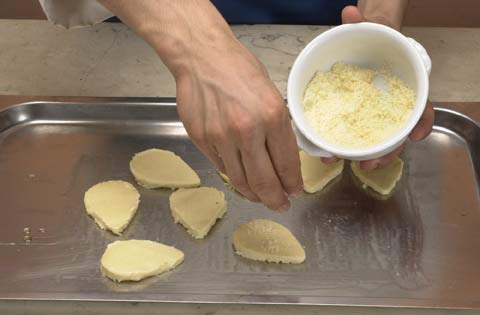 |
| Sheep Grazing on the Outskirts of Rome |
To make authentic Roman gnocchi you need two things: semolina and pecorino romano cheese. Semolina is the base of the dish while pecorino cheese gives the dish additional levels of flavor.
Ingredients
6 tablespoons butter, plus 2 tablespoons for sheet pan and baking dish
3 cups milk
1 teaspoon salt
1 cup semolina flour
1/2 cup freshly grated Pecorino Romano cheese for the preparation, plus 1/2 cup
4 egg yolks
Preheat oven to 400 degrees F/204 degrees Celsius
Preparation
 |
| Step 1 |
Step 1
In a large pan, heat the milk until it just barely begins to boil. Add the salt and pepper. Pour the semolina into the milk in a thin stream, taking care to mix it in well after each addition in order to avoid lumps from forming. Let it cook for a few minutes.
In a large pan, heat the milk until it just barely begins to boil. Add the salt and pepper. Pour the semolina into the milk in a thin stream, taking care to mix it in well after each addition in order to avoid lumps from forming. Let it cook for a few minutes.
 |
| Step 2 |
Step 2
Once it has thickened, take the pan off of the heat, mix in the yolks and the nutmeg.
Once it has thickened, take the pan off of the heat, mix in the yolks and the nutmeg.
 |
| Step 3 |
Step 3
At this point, add ¾ of the grated Pecorino and mix carefully.
At this point, add ¾ of the grated Pecorino and mix carefully.
 |
| Step 4 |
Step 4
Blend in the butter, and roll out the dough on a surface greased with melted butter or oil. Lightly grease the surface of the dough and with the aid of a sheet of oven paper and a rolling pin, roll out the dough to a thickness of 0.2 inch. Let it cool.
 |
| Step 5 |
Step 5
With a teardrop-shaped pastry cutter, or a small glass, cut out the “gnocchi”.
 |
| Step 6 |
Step 6
Arrange them on a greased baking pan.
Arrange them on a greased baking pan.
 |
| Step 7 |
Step 7
Sprinkle the dumplings with the remaining Pecorino cheese and brown them in the oven at 400 degrees F/204 degrees C for a few minutes. Watch them closely!
You can also arrange the gnocchi so that they are leaning up against one another (overlapping) in a buttered baking dish and sprinkle with the remaining grated cheese. Place in a preheated oven (425 degrees F/218 degrees C) and cook 15 to 20 minutes, or until top is deep golden brown. Remove and serve immediately.
Sprinkle the dumplings with the remaining Pecorino cheese and brown them in the oven at 400 degrees F/204 degrees C for a few minutes. Watch them closely!
 |
| Overlapping Gnocchi |
Another variation is gnocchi with gorgonzola. Sprinkle the gnocchi with crumbled gorgonzola and the remaining grated cheese and bake as above.
A couple of tips: The semolina must be added to just boiling milk, otherwise it will not thicken, and add the nutmeg when the semolina mixture has been taken off the heat. If added during cooking you will lose its aroma and fragrance.
Also the egg yolks and pecorino cheese should be mixed into the dough after it has been removed from the heat, otherwise it causes havoc with the egg yolks and your gnocchi won't be good.



























